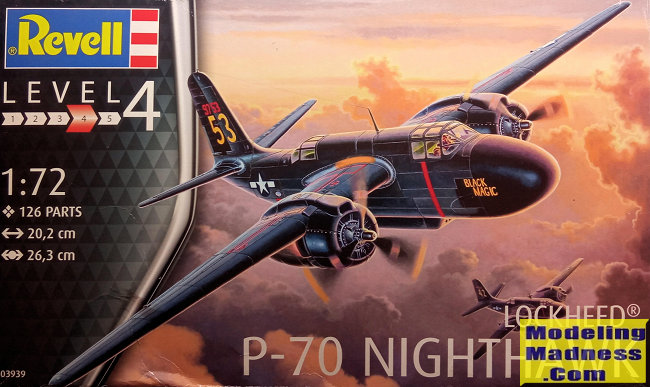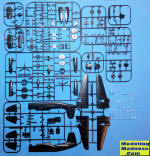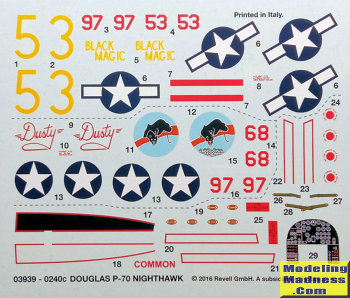
Revell/MPM 1/72 P-70 Nighthawk
| KIT #: | 03939 |
| PRICE: | $25.00 |
| DECALS: | Two options |
| REVIEWER: | Spiros Pendedekas |
| NOTES: |

| HISTORY |
| THE KIT |
 MPM launched their very nice 1/72 A-20 family in 2007, starting with the A-20G,
then regularly reboxing the molds with occasionally new parts, practically
covering every version of the plane and from 2014 onwards carrying the Special
Hobby logo. Revell has reboxed the kit twice, in 2012 as Boston Mk.V/A-20J and
in 2016 as the P-70 Nighthawk, which is the subject of this preview. The
specific kit was a gift from my Polish friend Bernard Sobczyk, who was even more
generous by including a set of Eduard masks and Armory resin wheels!
MPM launched their very nice 1/72 A-20 family in 2007, starting with the A-20G,
then regularly reboxing the molds with occasionally new parts, practically
covering every version of the plane and from 2014 onwards carrying the Special
Hobby logo. Revell has reboxed the kit twice, in 2012 as Boston Mk.V/A-20J and
in 2016 as the P-70 Nighthawk, which is the subject of this preview. The
specific kit was a gift from my Polish friend Bernard Sobczyk, who was even more
generous by including a set of Eduard masks and Armory resin wheels!
The kit comes in the usual (now black, not blue) side opening Revell box, made
of good quality cardboard, carrying a very attractive box art of artist Andrzej
Deredos, depicting two P-70s flying during sunset. Upon opening the box, I was
greeted with around 180 black styrene parts, arranged in seven sprues of various
sizes. Of them, only around 120 are to be used for the specific version, as the
sprues feature parts for the other variants (like bomber/navigator compartment
bits, different exhausts, noses, armament, antennas and so on), meaning you will
be left with a considerable amount of leftover bits, which might at cases be
useful for your future projects (like the antennas, for example).
Being one of the later MPM offerings and though still limited run in nature,
this kit has done solid steps towards being mainstream. Molding, apart from some
not too prominent mold lines, is quite crisp without flash, there are helpful
locating pins in quite a few areas and panel lines are finely recessed. Some
sprue gates might be found at awkward places, like near the finely detailed prop
hubs, deeming parts removal from the sprues not an always easy task. Though
looking more “shiny” than we are used to, the styrene itself is of good quality,
reacting positively to normal glue, something very helpful, especially when
dealing with less mainstream kits.
Cockpit and radar operator’s compartment are thoroughly done for the scale,
including all main items found in the real plane. The instrument panel features
nicely molded instruments, with a good looking decal to be (optionally) placed
onto. Seat belts are provided as decals, a nice touch for the scale. The radar
operator’s office features the expected plethora of consoles and the correct for
the version seat. Though not sure if it was always fitted, I would not mind if
the famous liferaft that was stowed aft of the pilot’s cushion would be provided
(if you want to replicate it, you should either scratch build it or go for a
resin aftermarket).
Landing gear is finely represented, with the legs featuring scale thickness (a
good think realism-wise, but, maybe, not that good regarding strength), the bays
are fully boxed and well detailed and the wheels look good. The other key area
of the engines is equally well represented and the props look fine. The
aerodynamic surfaces are nicely done and this includes the fabric
representation.
Transparencies are crisply molded with well defined frames and crystal clear.
Instructions are excellently done per the “New Revell Style”, provided in the
form of a 16-page color A4 booklet, including a reference photo of a completed
model, a sprue diagram, with the construction spread in 36 clear, concise and
followable steps, with color callouts included where applicable.
 Two schemes are provided, for two quite famous P-70s: one is “Black Magic”,
#9753, a bird used for training crews, as it stood in California, early 1944 and
the other is “Dusty”, #9768, as it stood in the Pacific Theater in late 1943.
Both are overall black, with “Black Magic” carrying a sort of two tone black
scheme (presumably featuring the original, partly faded black, with some freshly
painted areas). Colors are given in Revell codes and in generic form. Decals are
supremely done by (almost definitely, though not imprinted) Cartograf and
include maintenance stenciling.
Two schemes are provided, for two quite famous P-70s: one is “Black Magic”,
#9753, a bird used for training crews, as it stood in California, early 1944 and
the other is “Dusty”, #9768, as it stood in the Pacific Theater in late 1943.
Both are overall black, with “Black Magic” carrying a sort of two tone black
scheme (presumably featuring the original, partly faded black, with some freshly
painted areas). Colors are given in Revell codes and in generic form. Decals are
supremely done by (almost definitely, though not imprinted) Cartograf and
include maintenance stenciling.
Instructions want you to assemble the cockpit and radar operator office, then
trap them between the fuselage halves. The two distinctive aft-located oval
windows have to be attached beforehand, however I would consider replicating
them with Clearfix or a similar product. The wings and tail planes are then
assembled and attached, followed by assembling the engine nacelles/main bays,
and the engines themselves.
Landing gear is then put together and installed. The main legs have to be
attached prior to attaching the nacelle/main bay subassembly to the wings and,
though tempted, I doubt if it is possible to attach them afterwards
uneventfully. The underside gun tray is then attached (you may wish to open up
the gun holes and ejector chutes for extra realism), followed by the props, the
top engine air inlet extensions (expect some fit issues there), the nose (you
have to choose the correct for your version), the antennas’ suite (again, the
correct for your version) and, finally, the canopies.
The kit clearly possesses a certain level of complexity, aiming to the more
experienced modeler, this being very true, taking into account its “limited run”
nature.
| CONCLUSIONS |
This is a very comprehensive kit of the iconic P-70. Shapes of parts look
correct, panel lines are finely recessed, molding is good, details are plenty
all over (the key areas included), transparencies look great, instructions are
thorough and decals are superb.
Though vastly departed from the first MPM attempts and approaching mainstream
offerings, this is still a limited run kit that will require your extra
attention (cleanup, test-fit three times, then attach), so the novice modeler is
typically excluded from the potential builders. The kit is definitely buildable
and an average modeler, apart from the extra cleanup/test-fit, will have no
difficulty putting it together.
As of 2023, this kit is by far the most detailed P-70 of all scales, the same
being true for the other MPM/Special Hobby versions of the whole A-20 family.
Surely not shake and bake, but, on the other hand, not that difficult and
offered at very sensible prices, if you have some modeling experience and do not
mind walking the “test-fit, sand, repeat” extra mile, this is a kit worth
tackling.
My sincere thanks to Bernard Sobczyk for sending me this kit.
Happy Modeling!
March 2023
Copyright ModelingMadness.com. All rights reserved. No reproduction in part or in whole without express permission from the editor.
If you would like your product reviewed fairly and fairly quickly, please contact the editor or see other details in the Note to Contributors.